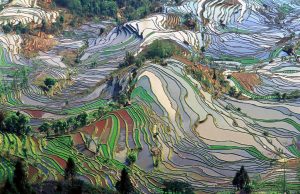Environmental Consequences: GM Rice
Genetically modified rice have benefits and negative consequences for different parties involved. For Farmers, it may be beneficial since it seems to be cost effective and produce a higher yield. Using less pesticides may actually increase crop yield according to Qaim & Zilberman (2003), and hybrid rice is modified to use less resources when it is grown. However if it is not contained properly, then there may be consequences for the natural environment.
Pros:
- GM Rice uses up to 30% less water than regular crops (Pray et al. 2011, p. 1733)
- It requires little to no pesticides
- It can be modified to withstand droughts and other extreme weather (this is needed due to anthropogenic effects on climate changes)
- It produces more yield than regular crops that is beneficial to farmers
Cons:
- Potentially ecologically harmful-as it can crossbreed with other plants and produce strong weeds that can become invasive and hard to control
- No long term research-GM crops, specifically rice has not been studied for its long term effects. No one knows if they may pose a health issue in humans (Public Health concerns)
- Agricultural economics- China will soon be self sufficient in terms of growing rice, so there would be no point in commercializing GM rice (Wang & Johnston 2007).

Genetically modified rice can potentially be a solution to China’s food security problem. There should be long-term research on the effects of the grain before it would be approved, to determine its consequences on health. If farmers take all precautions when sowing and harvesting it, it can be a sustainable option.
Sources
- Qaim, M., & Zilberman, D. (2003). Yield effects of genetically modified crops in developing countries. Science, 299(5608), 900-902.
- Pray, C., Nagarajan, L., Li, L., Huang, J., Hu, R., Selvaraj, K. N., Napasintuwong, O., & Babu, R. C. (2011). Potential impact of biotechnology on adaption of agriculture to climate change: the case of drought tolerant rice breeding in Asia. Sustainability, 3(10), 1723-1741.
- Wang, Y., & Johnston, S. (2007). The status of GM rice R&D in China. Nature biotechnology, 25(7), 717-718.
- Rozelle, Scott, Jikun Huang and Ruifa Hu. (2005). “Genetically Modified Rice in China: Effects on Farmers in China and California.” ARE Update 9(1):2-6. University of California Giannini Foundation of Agricultural Economics.
http://giannini.ucop.edu/publications/are-update/issues/2005/9/1/genetically-modified-rice/ -
Terrace field yunnan china denoised [Terrace rice fields in Yunnan Province, China.]. (n.d.). Retrieved December 6, 2016, from https://commons.wikimedia.org/wiki/File:Terrace_field_yunnan_china_denoised.jpg
